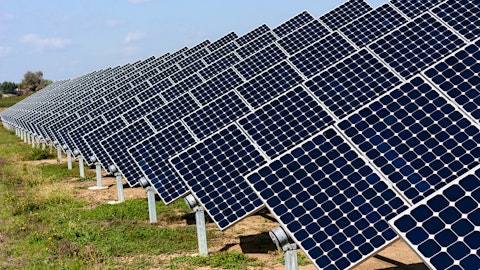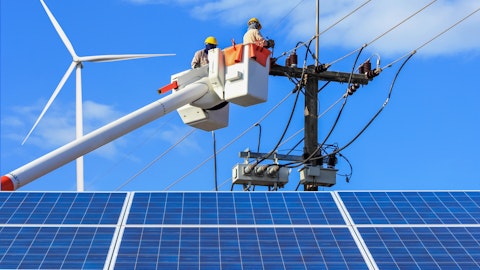Justin Clare: Got it. Okay. That’s helpful. And then just on the financing of the acquisition, can you share the mix of the financing between the Blackstone facility and then how much equity is required here. And then you did talk about the possibility for attractive further acquisitions here. Could you talk about your capacity to make further acquisitions, given your cash on hand and your – the different sources of debt financing that’s available to?
Dustin Weber: Sure. So the first point to make is that this financing fits nice – sorry, this acquisition fits nicely into our current facilities that will be upsized to support the acquisition and there’ll be a good portion of the acquisition will be funded through the Blackstone long-term debt facility, combined with cash on hand. As you heard, the effective rate of this financing will be a bit lower, i.e., there will be a benefit from the interest rate hedge. So there’ll be a predominant use of long-term debt and some lesser amount of cash on hand. In terms of our long-term capacity to continue to pursue the robust opportunity of deals in front of us, both on the development and the acquisition side. We do have plenty of capital to support those transactions — and I want to reiterate that we have no intention of issuing equity or equity-linked instruments to support that growth.
The access to debt financing that we have, whether it be Blackstone or other debt financing is adequate in order to support our growth plans.
Justin Clare: Got you. Okay. And then maybe just one more. It looks like you moved a decent amount of assets into the construction bucket here in this quarter. Wondering what you’re seeing for construction time lines. And I’m also trying to get a sense for when do you need to have all the assets under construction in order to hit your target for next year of 150 megawatts of self-developed assets?
Dustin Weber: Sure. Yes, Justin, we’re very happy. Over 50 of the 75 megawatts that have been in construction this year have been molding operation, and we’re busy finishing up the rest. In fact, many of the ones that are not yet in the finished column are actually completed. They’re built and they’re just sitting around waiting for the utility to come by either in inspected or for the utility to put up their polls so that we can complete those. So it’s been a very interesting year. A lot of companies in our space apparently have had some headwinds and are running into market conditions that are causing them to slow down. We are not. We’ve had and will have the best construction year ever for Altus with a 75 megawatts of completion once we get to the end of the year in 6 or so weeks.
We feel very good about continuing to grow that platform. And so while others are sort of cutting and slowing down, we’re increasing the size of the platform. We’re investing in more staff and expanding our capacity further as we continue to scale up. We have already started with some of the construction for assets that are going to be completed next year, and we look forward to providing some more details on our fourth quarter call as we have more visibility into the exact number and makeup of the assets we’re going to complete building next year.
Justin Clare: Got it. Okay. Thank you.
Operator: Thank you. Our next question is from the line of James West with Evercore ISI. Please go ahead.
James West: Hey, good morning, guys. I wanted to follow up on Altus IQ. Really interesting introduction here. I know you dug into some of the details, but I was curious about the rollout of this product. I know you’ve rolled it out to a few customers so far. What’s the plan to attack the rest of the existing customer base? And then maybe secondarily, what will this be offered kind of with every project going toward? I’m assuming it will be?
Julia Sears: James, that’s a great question. And nice to meet you. We’ve had, to your point, rollout earlier this year, we started in February with several clients, and we’ll continue to do that with clients that are a part of what we call Altus fit [ph] So whether they’re a part of looking at energy optimization for their organizations or they are looking at solar solutions and offsets, we want to provide a solution that helps any one of those categories and can help grow that space. From a rollout perspective, today, if you go to the public website, you can look under commercial and see a tab for IQ. You can see the base features of the product and also had a request a scheduled demo and get involved with our team internally. We welcome folks that are either within our organization as an existing clients or new clients or part of our partners to be a part of that growth.
Lars Norell: And James, this is Lars. We’ve been beta testing IQ with some of our existing customers that we have been delivering clean electric power to for some time to make sure that we can begin to have a sense for how they want this user interface to work. And we ultimately will roll it out so that all our existing customers are able to be on it. And frankly, one of the very simple features in there is to pay your bill. And so the ability for large corporates to basically access their billing in one place has proven to be very valuable to them, and it’s relatively straightforward for us to set up. But it’s in the interaction with new customers, new development customers, both from Blackstone and from CBRE in particular, that we’re noticing that there’s a great deal of excitement about what IQ can do for them.
And so one of the things, it takes a while for us, as we’ve talked about on prior calls, it takes a while for us to onboard a large enterprise customer into our solar program. There’s a lot of stakeholders at very large entities and they all need to be consulted and they have their internal processes, et cetera, et cetera. We’ve been wanting to see if there’s some way that we can connect early with those customers in an actual commercial relationship. And so to frankly, take them off the market a little bit while they’re busy looking through buildings and listening to engineering reports, et cetera, and so forth. And so Altus IQ is that way. We can now begin to serve these corporate customers very early in the process. And while a solar system might take 9 or 12 or even 15 months to build, onboarding buildings onto Altus IQ can be done in a day.
And so the ability for us to connect with those customers is going, we think, to prove very, very – it’s going to provide us with a very nice competitive advantage.
James West: Okay. Got it. Thanks, Lars. And then maybe just another question for me. Gregg, When I saw you recently, we talked a bit about community solar, and I think that’s going to be a pretty big platform going forward and a pretty big opportunity going forward. I wonder if you could elaborate on how you guys are thinking about community solar. I know there’s 9 or 10 or so states that do have programs in place, but that will probably roll out some more over time? And what – how Altus going to participate in this?
Gregg Felton: Sure. It’s a great topic of conversation, James. And we are incredibly well positioned to continue to roll out community solar programs across the country as and when these programs proliferate. And we really view this as a TAM or total addressable market expander for the company. As you know, we’re – our reach in terms of our relationships or our customer relationships and the real estate that we touch is global, but it’s specifically across the U.S. And as community solar programs roll out, for example, the largest state in the country, California, has yet to introduce, but is on the horizon. In 2024, it’s anticipated. So we are well positioned. We already have the real estate relationships, and we will look to pursue community solar expansion in every market where it’s coming. And so it’s a very exciting opportunity for us. Lars or any…


